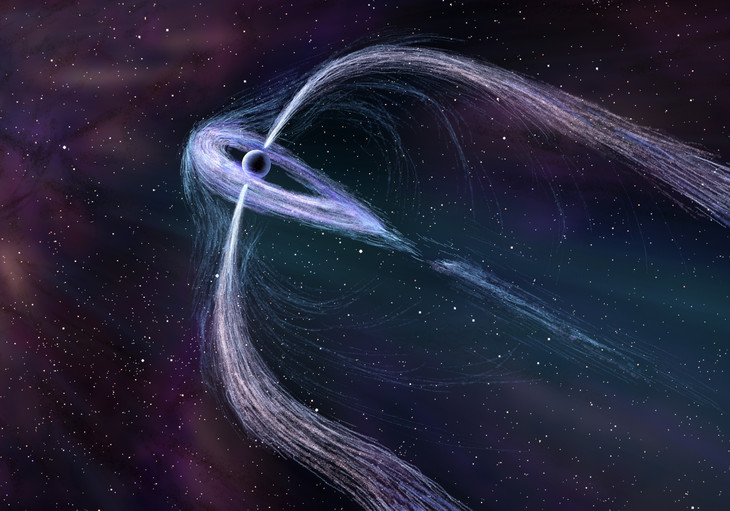Astronomers are exploring a celestial particle accelerator in the Eel Nebula that surrounds a distant pulsar.

Nahks TrEhnl
Take a coin out of your pocket and flip it. That coin-flip carries a peta-electron-volt (PeV) of energy. Now imagine a particle a million billion times smaller than your coin, far beyond the range of even the most powerful microscope — and it’s flitting by with that same amount of energy. That one particle surpasses by a thousandfold the energy that humanity’s most sophisticated particle accelerators can generate.
Yet the universe has no shortage of such exceedingly energetic particles. They slam into Earth’s atmosphere all the time. But while astronomers have long known these potent particles exist, they’ve struggled to understand how they come to be. Only recently has data begun to shed light on this phenomenon.
A Twisted Path
The trouble is, PeV particles are generally charged, whether they be protons or electrons. As such, they’re susceptible to the manipulations of magnetic fields, their paths bending this way and that as they pass through the galaxy. Tracing a single particle back to its source is nigh impossible.
But the processes that make energetic particles also makes gamma rays. And gamma rays, being chargeless photons, are not so easily led astray by the galaxy’s swirling magnetic field. These photons are thus the messengers that can tell astronomers where particles are being accelerated — and how.
Two facilities have come online in recent years to give astronomers access to the highest-energy gamma rays: the Large High Altitude Air Shower Observatory (LHAASO) in Tibet and the High-Altitude Water Cherenkov Observatory (HAWC) in Mexico. Their data has enabled astronomers to identify roughly a dozen possible cosmic particle accelerators, known as Pevatrons.

Institute of High Energy Physics of the Chinese Academy of Sciences
The Eel Nebula
One of these Pevatron candidates is the Eel Nebula, 11,400 light-years away in the constellation Scutum. In this nebula, a cloud of charged particles surrounds a pulsar as it speeds through space, leading to its distinct snakish shape.
Using observations not just of gamma rays but also X-rays and radio waves to describe the particle cloud, Daniel Burgess (Columbia Astrophysics Laboratory) and team put together a computer model that describes the current state of the pulsar, the plasma around it, and their evolution over time. In a study to appear in Astrophysical Journal (preprint available here), they show that this particular Pevatron is accelerating electrons to PeV energies.

Daniel Burgess et al.
“This is one of the first unambiguously identified [electron-accelerating] PeVatron candidates,” says Henrike Fleischhack (Catholic University of America). “The follow-up observations and detailed modeling presented here . . . can serve as a blueprint for the study and identification of other PeVatron candidates.”
Indeed, team member Kaya Mori (also at Columbia Astrophysics Laboratory) confirms that the team is working on applying the same technique to multiple other pulsar clouds, including two nebulae evocatively named Dragonfly and Boomerang. Other teams are investigating alternative Pevatrons, such as the shocked plasma bubbles cast out by supernova explosions.
While the Eel Nebula is a clear candidate source of PeV electrons, Fleischhack points out that the energetic particles observed at Earth consist of not only electrons but protons. And so far, most of the other candidate Pevatrons have been found to only accelerate electrons.
“The question remains,” Fleischhack says: “Where are the [proton-accelerating] PeVatrons that we know must be out there?”
 1
1









Comments
albert poncedeleon
May 21, 2022 at 11:36 am
The night sky is full of so many surprises. Sky and telescope always brings to my attention new celestial bodies that I overlook or miss during my DSOs imaging. I would like that in these articles, the writer or journalist could identify or annotate the location of DSOs as interesting as this one. I know that the effects are visible only in x-rays and gamma rays, but at least I would like to try to image it in its luminance. Thanks SnT.
You must be logged in to post a comment.
You must be logged in to post a comment.